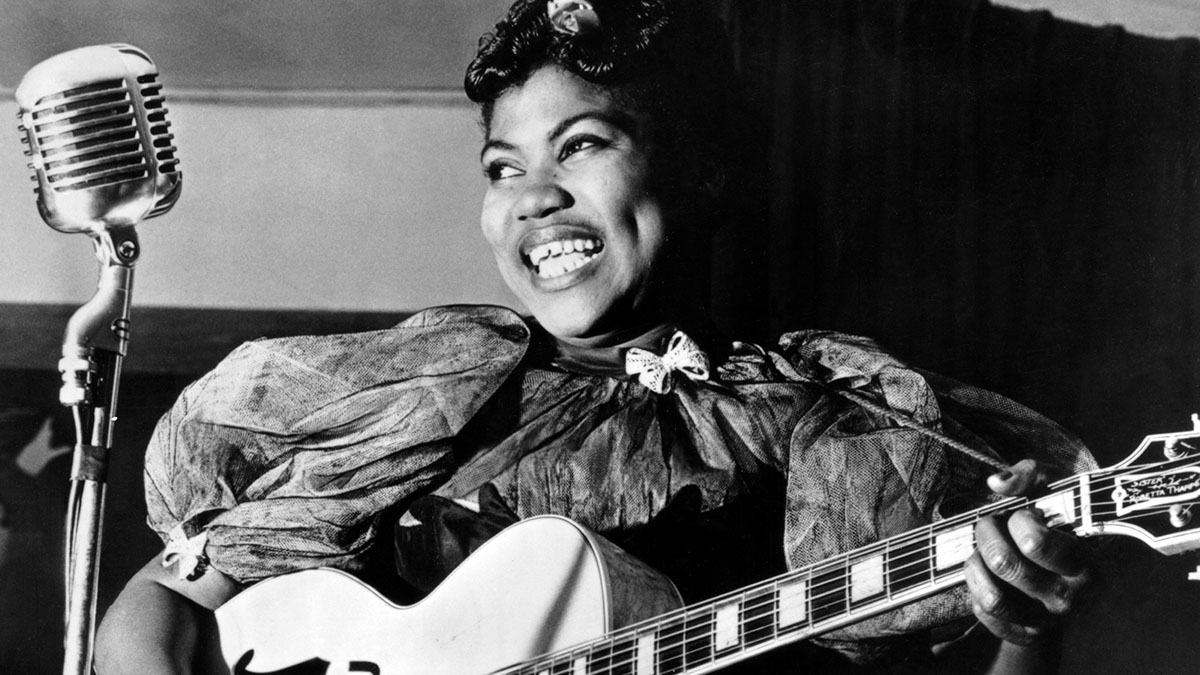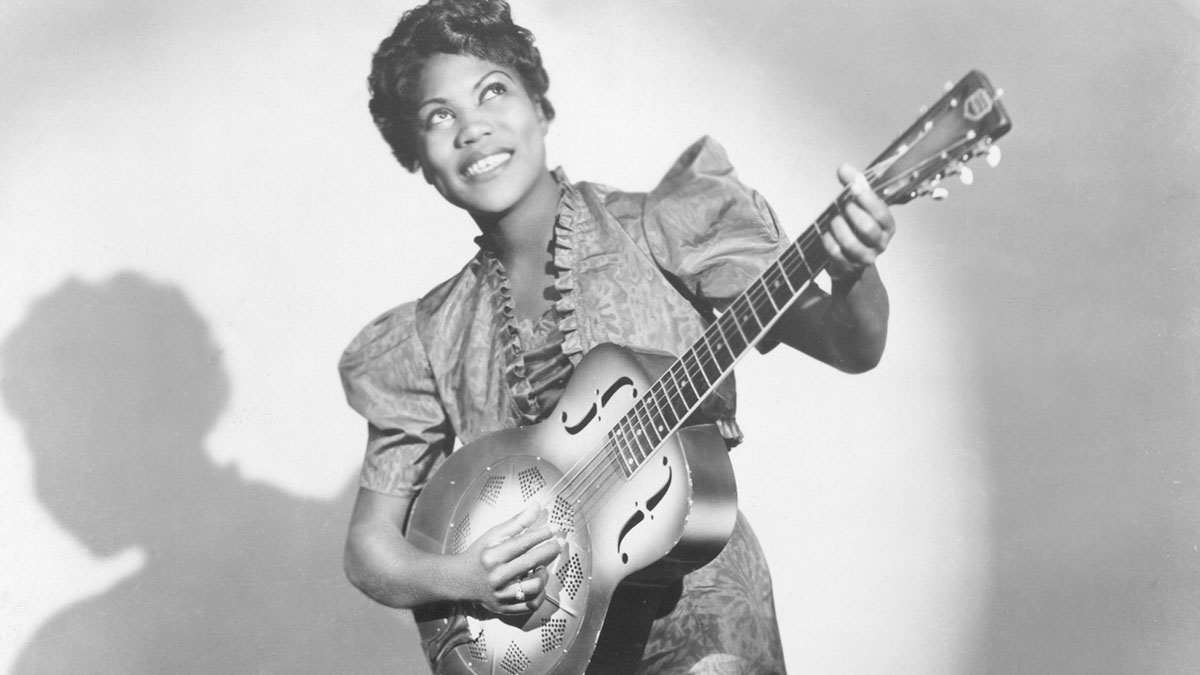
Rosetta Nubin was born on 20 March 1915 in Cotton Plant, Arkansas, a small town sandwiched between the Midwestern and Southern states. Both parents were cotton workers, although Rosetta didn’t know much of her father except that he sang in his spare time. Her mother, Katie, was deeply ensconced in the local church as both deaconess, vocalist and mandolinist.
Clearly a child prodigy, by the age of six Rosetta was performing with her mother, singing and playing guitar under the name Little Rosetta Nubin as part of a travelling evangelical group.
Even at this early stage Rosetta was spoken of as a formidable talent on the guitar. Throughout the 1920s, she further honed her skills after relocating with her mother to Chicago, performing in gospel music ensembles locally alongside the occasional nationwide tour.
It was around this time that Rosetta started to hear the first recordings of such blues queens as Ma Rainey and the trio of Smiths – Bessie, Trixie and Mamie. This was the era when blues was dominated by female artists shortly before the first Delta, or country blues, recordings were made. Rosetta was right in the thick of it, absorbing the music of her church roots and mixing in a dose of the blues – a controversial pursuit at the time.
In 1934, aged just 19, Rosetta married for the first time. His name was Thomas Thorpe, a preacher who was part of the touring troupe that Rosetta and Katie were involved with. The marriage lasted just four years, but in that time Rosetta Nubin became Sister Rosetta Tharpe, a slight deviation from her husband’s name.
Decca daze
Big Band leader Lucky Millinder led an orchestra from the mid-1920s to the mid-’50s that served as a breeding ground for many future stars of jazz and blues. Bull Moose Jackson, Wynonie Harris and Ruth Brown were among those who later found fame as R&B took hold into the 1940s.
Tharpe joined Millinder’s orchestra for her first recordings at the end of October 1938 waxing four sides for Decca. That’s All and My Man And I feature just Tharpe’s voice and Delta-infused National guitar. Sounding for all the world like a female Robert Johnson, Rosetta’s sparkling voice soared over her accompaniment, demonstrating her mastery of the country blues style perfectly.
The Lonesome Road – an evergreen jazz standard with a gospel-leaning lyric later recorded by the likes of Frank Sinatra and Nat King Cole – sees Rosetta performing solely as vocalist, her church-influenced yet blues-drenched voice perfect for this material.
It’s with Rock Me, however, that we hear Tharpe’s electric guitar for the first time and, significantly, this is the very record that had such a profound influence on future rock ’n’ rollers such as Elvis, Little Richard and Jerry Lee Lewis.
It’s a typical 16-bar blues sequence, for the time, where Rosetta’s now patent bluesy-gospel vocal blends effortlessly with Millinder’s standard swing-era big band arrangement. But it’s the opening 16-bar guitar solo that caused such a stir and is nothing short of revolutionary.
Big Bill Broonzy’s It’s A Low Down Dirty Shame featured the first electric guitar sounds on a blues recording courtesy of the legendary George Barnes and was recorded a mere seven months before Tharpe’s Rock Me solo. In turn, both recordings are almost a year before the first records by Charlie Christian were issued.
Sister Rosetta truly was a force and highly influential in the electric guitar’s early days, a fact so often overlooked. It’s a beautifully melodic solo full of subtle slides and string bends, and sounds as though it’s taken as much from country music as it has blues.
The song was a huge hit and made Rosetta a star despite the controversy surrounding the recording, which, effectively, is a gospel song performed in a secular style. It was a full 16 years before Ray Charles got the credit for mixing sacred with secular with his seminal I Got a Woman record from 1955. But it was Rosetta who was the true pioneer.
Breaking ground
A stream of historically important recordings followed. This Train, Trouble In Mind, Shout Sister Shout, Nobody’s Fault But Mine and Strange Things Happening Every Day, her biggest hit, are just some of her recordings that are now acknowledged as groundbreaking and influential in those proto-rock ’n’ roll days. On these, and many other finely crafted records throughout the 1940s, Tharpe plays acoustically in a classic Delta style – each track allowing her guitar and voice to soar.
Rosetta also made several traditional gospel records in tandem with her more R&B-flavoured output, a clear sign that she felt some degree of guilt over becoming so well known as a secular pop star. After all, gospel was where her heart and musical roots lay. Regardless, she maintained this musical balancing act for the remainder of her career by which time it had become perfectly acceptable to combine the two.
As the ’50s dawned, Tharpe, like so many of her trailblazing contemporaries, found her career on somewhat of a downturn as a new generation appeared and proceeded to convert her innovations into rock ’n’ roll.
Similarly, on the gospel scene, the rise of Mahalia Jackson had a similar effect in making Rosetta sound old-fashioned, almost overnight. Tharpe continued to perform in nightclubs and on tour, but the hit records had dried up.
Crossing the pond
By 1957, Chuck Berry, Fats Domino, Little Richard, Elvis Presley and a host of others had firmly established rock ’n’ roll as the music of choice for ‘the kids’. In the UK, however, something else was going on in parallel with the new music emanating from across the pond: a vibrant and healthy scene for traditional jazz. One of its leading lights was trombonist Chris Barber who had led a band that included Lonnie Donegan since the late ’40s.
During Barber’s concerts, Donegan would play what became known as a ‘skiffle break’ where he’d perform songs by the likes of Woody Guthrie and Lead Belly. These interval sets kicked off a whole movement in British music that directly led to the ‘blues boom’ of the 1960s.

Aside from this, Barber took it upon himself to bring over many blues and jazz musicians from the States to perform with his band, therefore introducing UK and European audiences to heroes that had only been heard on record before.
It was tours featuring the likes of Big Bill Broonzy, Sonny Terry & Brownie McGhee, Muddy Waters and, in 1957, Sister Rosetta Tharpe that had such a profound impact on young British musicians who are now household names such as Peter Green, Paul McCartney, Eric Clapton, Keith Richards, Jimmy Page and Jeff Beck. The list is endless – and the rest is history!
The 1957 tour was a huge success and put Rosetta firmly back on top. She came to the UK again in 1958 and in 1964 she toured as part of the Blues & Gospel Caravan, which also featured Sonny Terry & Brownie McGhee, Muddy Waters, Otis Spann, Rev Gary Davis and Mississippi John Hurt.
Going electric
It’s from the late ’50s through the ’60s that we are blessed with some incredible live footage of Rosetta singing and playing. By this time, she’d gone fully electric and was playing the guitar with a ferocity that foreshadows Townshend, Clapton, Beck, Page and Hendrix. Her signature licks are full of clever use of chromatics, doublestops and triplets, all delivered with such ease.
Tharpe favoured a thumbpick for single lines and rhythm, freeing up her other fingers to pick out those Delta licks at which she was also a master
They’re fluid and melodic with a rhythmic drive that can only be described as being ‘in the pocket’. Her sound and approach was quite unlike the bulk of blues guitarists at the time and actually allow one to see the beginnings of the path the music was to take as it strived to see itself beyond the pentatonic box.
Tharpe favoured a thumbpick for single lines and rhythm, freeing up her other fingers to pick out those Delta licks at which she was also a master. She played through Gibson tube amps in her early electric days, simply because they were the only ones available, and had no problem turning them up full!
In fact, Rosetta is often cited as one of the first guitarists to fully embrace valve overdrive. In later footage, Tharpe is plugged into either a 15-watt Gibson Falcon or a Vox AC30. She used ‘Vestapol’ tuning in D; imagine the notes of an open E chord tuned down a whole step to D A D F# A D.

Sister Rosetta Tharpe’s guitar collection is enough to make any vintage enthusiast salivate. In the early days she played a National Triolian Resonator, a wooden-bodied (as opposed to the later steel) guitar produced between 1938 and 1941, with it featuring on most of Tharpe’s Delta styled recordings.
By 1941, Rosetta is seen with a blonde Gibson L5 archtop that is likely the guitar she experimented attaching a pickup to later in the ’40s. For her 1957 tour with Chris Barber, Tharpe literally rocked up with a P-90-equipped Gibson Les Paul Goldtop with a trapeze tailpiece. You can imagine those young future rock stars gazing in awe at this imposing Black woman tearing off a barrage of distorted licks. It would have been truly mindblowing at the time.
In 1960, Tharpe was filmed at the Antibes Jazz festival backed by the Ian Wheeler & Ken Sims Sims Jazz Band. For this trip, her travel companion was a Gretsch G6117 Double Anniversary, a non-Bigsby version. Later in the ’60s, Rosetta is seen with a sunburst Gibson ES-330 and, in 1970, the year of her forced retirement, she was still purveying those piercing licks via a Gibson Barney Kessel signature model.
Making tracks
The one guitar Tharpe will forever be associated with, though, is her white 1961 Gibson SG Custom. This is the guitar that features on the majority of existing film, most notably the iconic footage of her playing at the disused Wilbraham Road train station in South Manchester on 7 May 1964.
Recorded for Granada TV while the aforementioned Gospel and Blues Caravan show was touring, the footage shows Sister Rosetta and the other members of the troupe performing on one platform while the audience sat across the tracks on the other.
The impact this show had cannot be underestimated as, for so many, it would have been their first exposure to authentic Black American music – music that was known well to the young musicians frequenting the blues clubs that had cropped up around the country but almost alien to the majority of the public. From this moment, the British take on the blues left the underground, exploded into the mainstream and things were never the same again.

Some 50 years of performing and touring finally caught up with Tharpe when, in 1970, she suffered a stroke that put an end to her touring life. She had lived with diabetes for several years, which, after the stroke, forced her to have a leg amputated. After recovering, Rosetta was booked for a recording session in October 1973. The evening before the session she suffered another – this time fatal – stroke at her home in Philadelphia.
Sadly, it wasn’t until 2008 that Tharpe finally had a gravestone to mark her resting place, but, by this time at least, interest in her life and work was renewed and in the years that followed Rosetta received several ‘hall of fame’ nominations. Tharpe also appears in the 2022 Baz Luhrmann-directed Elvis Presley biopic.
In the scene, a young Presley is in a late night club on Beale Street, Memphis, where he marvels at the voice of Sister Rosetta Tharpe (played by Yola) blending gospel and blues into an intoxicating cocktail of sound that Elvis himself – along with millions of others – was utterly captivated by.







